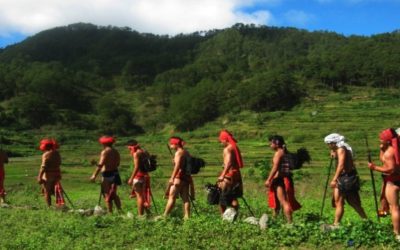Engage with us
Always be in the know.
Support our work.
Have a great idea?
Risk Profile








About this country
The Philippines is one of the most vulnerable countries in the world to disaster and climate change. With over 7,000 islands, and over 36,000 kilometers of coastline, nearly everyone – 74 percent of the population – and everywhere – 80 percent of the land area – are vulnerable to disaster, with the capital of Manila considered at “extreme risk.”
Typhoons and storms, which make up 58 percent of all disasters in the country, related flooding (25 percent) and landslides (six percent) pose the greatest threats to the country. Storms surpass all other disasters in terms of number of fatalities, people affected and economic damage. Though less regular than hydrometeorological disasters, earthquakes (five percent), volcanic eruptions (five percent) and drought (< one percent) can also have devastating effects. Cumulatively, these disasters cause an average of over 1,000 deaths per year.
The Philippines Government, INGOs and local NGOs are all making attempts to address climate change and disasters at various levels. However, many of the resources put aside for this purpose are re-directed to emergency response when disasters strike, such as Typhoon Yolanda (known as Haiyan internationally) in Nov. 2013, and the flash floods caused by Typhoon Sendong (Washi internationally) in Mindanao in Dec. 2011.
Attempts to defend the nation against disasters are complicated by social forces, such as high poverty, urbanization in coastal regions, and environmental destruction, including illegal mining and logging.
Learning Themes
• Resilience building in the context of protected areas;
• Safety of coastal communities in the Visayan region; and
• The role of local NGOs in disaster preparedness and response.
What’s New?
Enhancing Climate Change Resilience and Food Sustainability of Indigenous People in the Cordillera Region in the Philippines
The Cordillera Region in northern Philippines is mountainous with a fragile geophysical landscape. The slopes are denuded of trees and the grounds are unstable because of large mining activities. In 2009, Typhoon Parma caused a massive landslide in some of its...
read moreBuilding Resilient Coastal Communities: Building Back Better Maliwaliw in Eastern Visayas in the Philippines
The Eastern Visayas Region in central Philippines is a hotspot of natural hazards. It is prone to typhoons, storm surges, flooding, droughts, landslides, red tide, and volcanic eruptions. In November 8, 2013, the region was hit by Typhoon Haiyan, one of the strongest...
read moreResources
NGO Partners
Philippines
Lanao Aquatic and Marine Fisheries Center for Community Development, Incorporated (LAFCCOD, Inc.) lafccodincorporated@yahoo.com
Marge Dela Cruz
Executive Director
Guiuan Development Foundation, Inc.
117 Zamora St., Tacloban City
6500 Philippines
09189295852; 09173211942
www.gdf-i.org
marge.delacruz@gdf-i.org
cruzmarge2003@yahoo.com
Leodinito Y. Cañete
A2D Cebu
A2D Project – Research Group for Alternatives to Development, Inc.
405 JRDC Building, Osmeña Blvd.
Capitol Site, Cebu City
09989993868
leodinitocanete@gmail.com
Bai Raizsa Mae M. Anayatin
Mindanao Coalition of Development NGO Networks (MINCODE)
No. 3 Juna Avenue corner Camia Street, Juna Subdivision,
Matina, Davao City, Philippines
0908-8213457
mincodesecretariat@gmail.com
bai.anayatin@gmail.com
Agnes Bolanos
AGRI-AQUA DEVELOPMENT COALITION – MINDANAO
Waling-waling St., Buhangin, Davao City;
09209137980
asbolanos0701@gmail.com
Rhodora E. Pon-An
Antique Development Foundation (ADF), Inc. Carmenville Subdivision, San Jose, Antique;
0917-801-2896
adfantique@yahoo.com
Mary Jun Decafe-Nicolasora
Single Drop Consultancy Services, Inc.
048-434-1101
klee@singledrop.org
Luzviminda B. Quiňones
Ranaw Disaster Response and Rehabilitation Assistance Center Inc.
c/ o Disaster Risk Reduction Network-Philippines
Door 2 Maca-agir Apt. 6th East Rosario heights, Tubod, Iligan City
09261871839
drrnetphils.coordinator@gmail.com; rdrrac_inc@yahoo.com
Corazon Clarin
Cebu Disability-Inclusive Disaster Risk Reduction Network
(A2D Project) c/o Disaster Risk Reduction Network-Philippines
Cordova, Cebu
09334890761
clarincora@yahoo.com, drrnetphils.coordinator@gmail.com;
Disaster Risk Reduction Network-Philippines New Capitol Estates I, Batasan Hills, Quezon City
0917-594-1740
drrnetphils.coordinator@gmail.com
Ana Hazel Javier
PUSOD Inc
annhazel@pusod.org, ahjavier@yahoo.com
Maria Melania B. Samonte
NASSA CARITAS PHILIPPINES 470 GEN. LUNA ST. INTRAMUROS, MANILA
09175398535 / 094984640977
laniebsamonte@gmail.com
Lida Jonota
NASSA CARITAS PHILIPPINES 470 GEN. LUNA ST. INTRAMUROS, MANILA
0926-7034604 / 094984640977
ljonota.caritas@gmail.com
Alice Macay
SHONTOUG FOUNDATION, INC. Datacan, Kapangan, Benguet
09999916976
alicemacay@yahoo.com shontougfoundation@gmail.com
Mark Cervantes
Humanitarian Leadership Academy m.cervantes@humanitarian.academy
Rustico Biñas
Independent Global DRR Advisor
rusty.binas@yahoo.com
Zenaida Willison
Global Network for DRR
0928-227-4144
zenaidawillison@gmail.com
Kate Landry
Build Change’s Director of Programs and Partnerships in the Philippines kate@buildchange.org
Emily Oro
IIRR
emily.monville@iirr.org
Karina Reyes Antonio
Center for Sustainability PALAWAN,
917 797 9530
karina@centerforsustainability.org
Mr. Mikhail Valle
Citizens’ Disaster Response Center Foundation Inc.
info@cdrc-phil.com, cdrc_1984@yahoo.com




